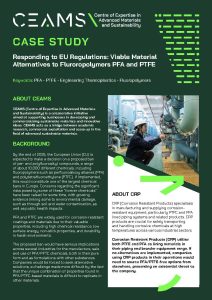CEAMS (Centre of Expertise in Advanced Materials and Sustainability) is a collaborative initiative aimed at supporting businesses in developing and commercialising sustainable materials and innovative ideas. CEAMS acts as a bridge between academic research, commercial exploitation and scale-up in the field of advanced sustainable materials.
Background
By the end of 2025, the European Union (EU) is expected to make a decision on a proposed ban of per- and polyfluoroalkyl compounds, a range of about 10,000 different chemicals, including fluoropolymers such as perfluoroalkoxy alkanes (PFA) and polytetrafluoroethylene (PTFE).
If implemented, this would constitute one of the largest chemical bans in Europe. Concerns regarding the significant risks posed by some of these “forever chemicals” have been raised for some time, with growing evidence linking some to environmental damage, such as through soil and water contamination, as well as public health impacts.
PFA and PTFE are widely used for corrosion-resistant coatings and materials due to their valuable properties, including high chemical resistance, low surface energy, non-stick properties, and durability in harsh environments.
The proposed ban would have serious implications across several industries for the manufacture, sale and use of PFA/PFTE chemicals, both in their pure form and as formulations with other substances. Companies would be forced to seek alternative solutions, a challenge made more difficult by the fact that the unique combination of properties found in PFA/PTFE-based materials is difficult to replicate in other materials.
CRP (Corrosion Resistant Products) specialises in manufacturing and supplying corrosion-resistant equipment, particularly PTFE and PFA lined piping systems and related products. CRP products are crucial for safely transporting and handling corrosive chemicals at high temperatures across various industrial sectors.
Corrosion Resistant Products (CRP) utilise both PTFE and PFA as lining materials in their piping and broader equipment range. If no alternatives are implemented, companies using CRP products in their operations would need to source PFA/PTFE-free options from elsewhere, presenting an existential threat to the company.
Project
Through this CEAMS collaboration, a Senior Application Scientist from the Henry Royce Institute (Royce) conducted a 4-month study to identify suitable materials that could be used to replace, wholly or in-part, PTFE and PFA usage in CRP’s product line.
Alternative materials would need to have processing similarities to PFA and PTFE to minimise re-tooling costs and staff retraining; they would need to demonstrate high chemical resistance, particularly against typical corrosive chemicals; and any candidate materials would need to match against a list of required properties.
It was also critical to consider the performance, cost and availability of any suitable alternatives to assess the feasibility of using these materials in CRP’s daily operations.
Results
After extensive review, several partial PFTE and PFA replacement candidates were successfully identified by Royce’s Senior Application Scientist.
Notably, these candidates can be processed with techniques already in use for PTFE and PFA and are anticipated to reduce the impact on CRP’s operations relative to other material alternatives. For example, extensive retraining of CRP’s workforce will be reduced, although significant retooling will likely still be required.
The resulting recommendations from the desk study encourage CRP to investigate the potential of candidates through a series of practical investigations.
Impact
The project identified several candidate materials that could potentially replace PTFE/PFA in some limited duties, all of which could be processed by CRP. Notably, the project also highlighted that there are no like-for-like alternatives for PTFE and PFA currently available.
Through the CEAMS programme, the team at Royce provided the dedicated technical expertise required to review extensive literature, enabling CRP to make streamlined research and development decisions ahead of the potential EU chemical ban.
By helping companies navigate a shifting regulatory landscape, CEAMS has gained the opportunity to help shape the future of the chemical industry as it transitions towards a more sustainable future.
"CEAMS expertise brought a dedicated resource to conduct this research, as well as a wider knowledge of the engineering materials landscape, which in turn has provided much greater certainty to the results than if the research had been conducted in house at CRP."
Corrosion Resistant Products




